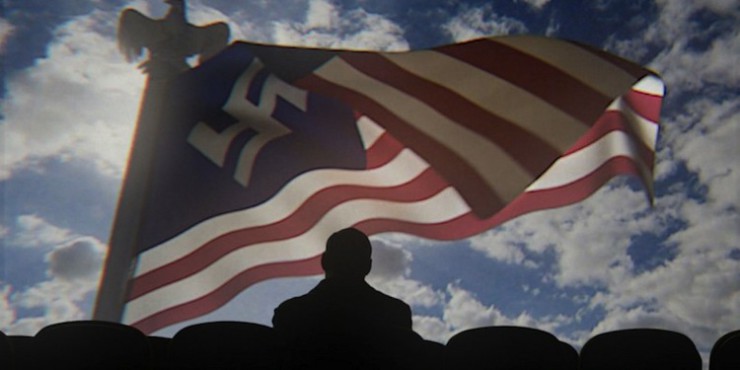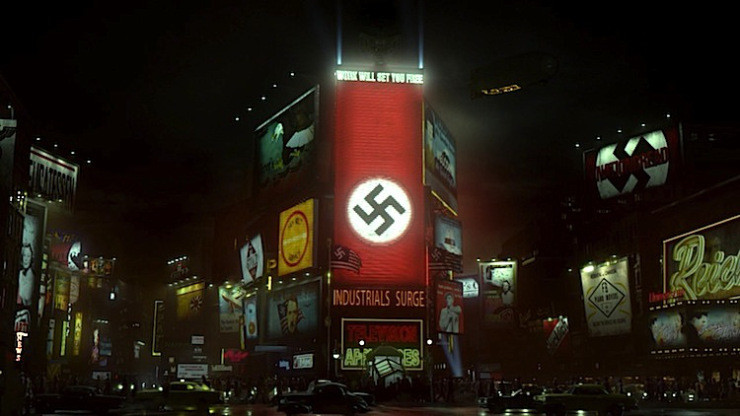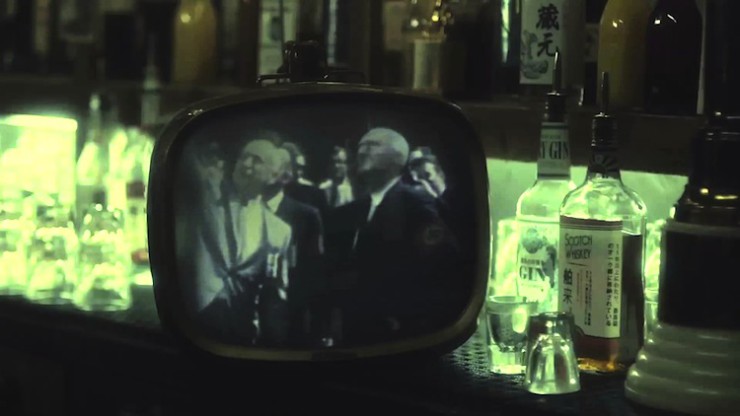In addition to Netflix’s Jessica Jones, I also bingewatched Amazon Studios’ The Man in the High Castle over this past weekend. This experience was interesting, as it represented the twin poles of current geek culture—two wildly different, equally complex takes on fantastical universes. Where Jessica Jones is deeply personal, dealing with intimate trauma and healing, The Man in the High Castle is an inventive, heady look at politics, that uses an alternate history to ask questions about society and humanity as a whole.
While both are emotionally wrenching, and feature nearly perfect performances from an absurdly deep bench of actors, the thing that stood out to me most in TMITHC was its worldbuilding. The plot of the show diverges significantly from that of the book, but it’s still fairly simple: The Allies lost World War II. In 1947, a bomb was dropped on Washington, D.C., and the Imperial Japanese Army and the Nazis divided the United States, with a swath of Neutral Territories cutting across the Rocky Mountains. Anyone not conforming to the Nazis’ ubermensch ideals has been exterminated, and both halves of the country live under tight fascistic control. In San Francisco, Juliana Crane ends up with a film that shows a very different outcome of World War II, and tries to smuggle it to the Resistance in the Neutral Territory, and Trade Minster Tagomi worries that Japan is weakening and becoming vulnerable to a Nazi takeover. Meanwhile, the Obergruppenführer of New York, John Smith, tries to use his agents to ferret out the East Coast Resistance, while investigating a plot to assassinate Hitler. See? Simple. But the plot is just a frame to hang an entire world on. The broad strokes the show makes are extremely impressive, such as this already iconic shot of Times Square bedecked in Nazi insignias:
But is goes far deeper than that. Every phone has the swastika-and-eagle stamp of the Greater Reich. The women of San Francisco hold themselves more like Japanese women of an earlier generation, with their heads tucked down, eyes politely averted. They walk with shorter steps, and often hold their hands folded in front of them. Everyone has their papers on them at all times. The family of Obergruppenführer Smith behaves, on the surface, much like an upper-middle-class American family would in the early ‘60s: Mother is both put on a pedestal and expected to be subservient to her husband; son is dutiful in school but occasionally teases his pop; younger sisters are seen but almost never heard; golden retriever is friendly. But son is also annoyed by the kids in class who show too much individuality, and he can’t wait to go see colonized Africa. Mother is pleased that people with congenital disorders are mercifully euthanized rather than having to live unfulfilling lives. Younger sisters are both maybe a little too quiet.
The show captures a frozen moment, where society has reached 1962 without the social upheavals of the 1950s. There has been no Civil Rights movement, no Claudette Colvin or Rosa Parks, because all non-whites have either been exterminated or fled to the Neutral territory of the Rockies. There has been no underground Beat poetry to tempt a certain type of teen—that sort of stuff would all be in the Neutral Territories where no suburban kid could get them. There have been no EC or MAD or Timely comics to destabilize a younger child’s brain, because all of their creators were Jewish. In case this wasn’t clear, the Jews were murdered over a decade ago, when the Nazis assimilated the United States at the end of the ’40s. There is no rock’n’roll, because there is “Negro music” and “acceptable music,” and the two do not meet. There will be no Velvet Underground because, not only is Lou Reed half-Jewish, he also would have been euthanized the day his parents took him to a hospital for mental health issues.
By far the most upsetting aspect of the show for me—more even than the horrific interrogation of the half-Jewish Frank Frink—was “VA Day”: a holiday celebrating the “liberation” of the United States.The day is an amalgamation of Thanksgiving and the Fourth of July, a day of national rest punctuated by fireworks, turkey, and apple pie. In the evening, everyone gathers around the TV to watch the parades in Berlin, and obviously listen to the Führer’s annual speech, while they eat snacks. The show presents this perfectly. It’s a matter-of-fact family holiday, exactly like watching the Macy’s Parade or a Thanksgiving football game.
I spent my binge of the show trying to track my own reactions. Why were the New York portions of the show more upsetting to me than those in San Francisco? Was it just that New York has become my home, so it felt more personal? Or is it that swastikas hold an emotional resonance beyond that of Imperialist Japan? While I know that the Japanese Army committed atrocities in China during World War II, they’ve never taken hold of the American imagination the way images of the Holocaust have. I was thinking about this when I saw a controversy around the show that’s going on right now, in New York.
For non-New Yorkers: the subway system here is, um… if not fully Lovecraftian, at the least non-Euclidean. Imagine if you took a plate of well-buttered spaghetti, threw it up in the air, and then encouraged several cats to have a wrestling match in the resulting pile. It’s my understanding that that’s how the train lines in the city were designed. Buried within the impressive tangle is an utterly straightforward train called the S. S stands for Shuttle, and it runs back and forth between Times Square station and Grand Central Terminal, to make it slightly easier for people to commute from Midtown’s East Side to West Side. (There is a second S that serves a similar purpose in Brooklyn, but we’re focused on Manhattan’s S right now.) It’s the simplest train in the city, it runs on a tight schedule, and when you get on it, you always know exactly where you’ll end up, because there’s only one stop. The weird thing about this train is that it is often uniquely branded, and completely wrapped in advertisements for one particular TV show or a type of soda. What does this have to do with an alternate history TV show about Nazis, you may ask? Well, this:
This was the S yesterday, when it was been branded with The Man in the High Castle. Which means that thousands of innocent commuters stepped into a nightmare at 8:00am, blinked sleepily around, and wondered where the hell they were. One of those commuters was Ann Toback, who is the head of The Workmen’s Circle, an organization that was founded in the 1890s to “foster Jewish identity through culture and social justice causes.” She talked to Gothamist about the branding, saying:
Half the seats in my car had Nazi insignias inside an American flag, while the other half had the Japanese flag in a style like the World War II design… so I had a choice, and I chose to sit on the Nazi insignia because I really didn’t want to stare at it.
Now, the ads have already been pulled, and I want to make it very clear that I think there were better ways to promote the show. But this also made me think about a very different type of worldbuilding. By allowing the show’s reality to bleed into our reality, the marketing team over at Amazon has (whether they know it or not) underscored the themes that Philip K. Dick explored in the book, and which Frank Spotnitz took in a somewhat new direction in his adaptation.
In the book version of The Man in the High Castle, The Grasshopper Lies Heavy is a novel-within-a-novel that tells of a different timeline, in which the Allies defeated the Axis. In the show, The Grasshopper is a series of films, each one different from the next, that show multiple alternate timelines. Some have the Allies winning. Some are about Stalin’s life after the war. Some show San Francisco decimated by an atomic bomb. It’s implied that there are hundreds of these films, each telling a different story. Are the dispatches from other worlds, sliding alongside the one in the show? Are they fictions? Who’s creating them, and to what purpose? Some of the characters see them as an inspiration, while others think that they’re pointless distractions, and others consider them dangerous.
By bringing the symbols of an alternate timeline into our world, the ad campaign is reinforcing the show’s intent to ask people to think about the world as it is now and as it could be. It forces people (possibly completely unfairly) to make a choice: Do I sit in front of the Nazi insignia so I can’t see it? Do I close my eyes? Which side of the train is more offensive, and why? In a way, these people are enacting the thought experiment that Dick began with the book to really ask what the point and power of storytelling can be.
I’m not sure The Man in the High Castle was a completely successful TV adaptation—it ends on a decidedly ambiguous note that made me wonder if it was worth the time I invested, and it also left so many plotlines unresolved that I found myself a little annoyed. But what it did well was powerful. Clearly, I’m still thinking about it several days later. I’ll still be thinking about it for quite some time.
Obviously as as a U.S. citizen, I have some conflicted emotions here. I love my country. I hate many aspects of my country. I hate many of the things the forefathers and mothers of my country did. I hate the Nazis. I have German heritage. My grandfather was a Secret Service agent who defended FDR, and toured the bombed-out shell of Berlin with Truman. I’m weirdly comfortable with Nazi paraphernalia, because I grew with it around the house, but it was in a very specific context: trophies taken from a defeated enemy, but my grandfather, who was on the right side. While my grandfather was collecting Iron Crosses to bring home, my partner’s grandmother was fleeing across the Austrian Alps, after escaping the Nazi factory she’d been forced to work in.
Given all that, it’s safe to say that this show was an emotional workout for me. But far more interesting I think is the intellectual workout. Given the current political climate, the refugee crisis in Europe, the constant fear of terrorism, the attacks on Black Lives Matter protesters, it would be easy to say that The Man in the High Castle is more relevant than ever.
But that’s a comforting fiction.
TMITHC has been relevant since it was written. It will always be relevant. The Nazis, and their admirers, we will always have with us.
The United States is not a country—it’s an idea. We have no racial identity here, because European settlers did their best to eradicate that. What we do have is a shared history that is reinvented and retconned and rebooted literally every moment. We’re an evolving idea, but as PKD would be the first to gently whisper as the dentist’s meds took effect—we can change the idea. We’re making the U.S. up as we go along. So, when I say worldbuilding—I’m not just referring to the fact that they CGI’d some swastikas onto the old Times building, and I’m not just referring to the way Alexa Davalos learned Aikido and practiced standing like a Japanese-influenced woman in 1963. We’re all building the world right now.
PKD reminds us that there are many versions of history, many turns it can take. In one, marriage equality was never passed. In another, women have full reproductive rights across the nation. In one, the U.S. welcomes all the refugees who come to its shores, and offers them a haven from the misery they’re escaping. In another, state governments claim rights they don’t actually have to shut them out. In one, everyone in this nation remembers that we came from somewhere else (except for those of us who didn’t) and tries to imagine a better world.
Leah Schnelbach would rather live in an idea than anywhere else. Come build a world with her on Twitter!













